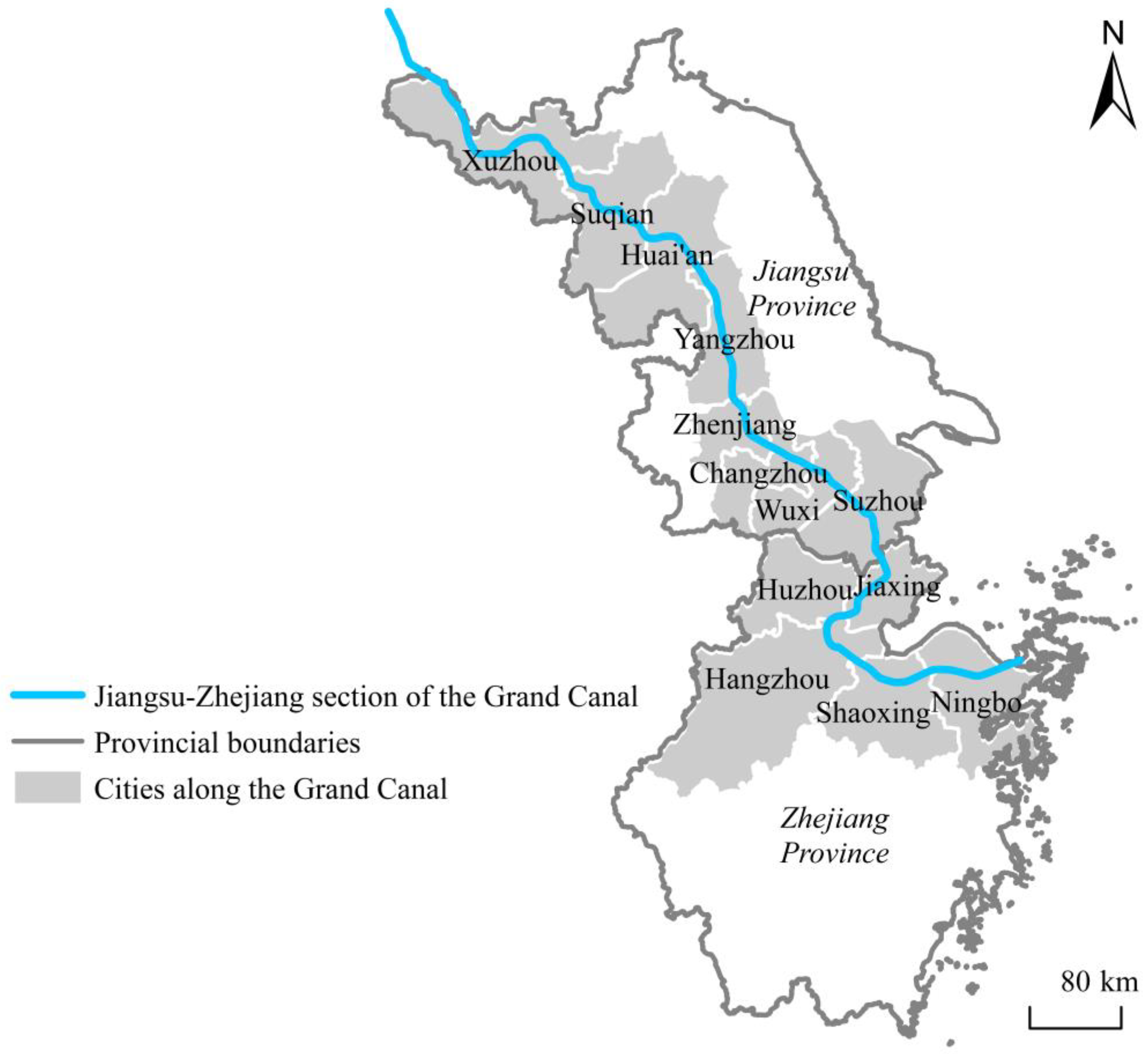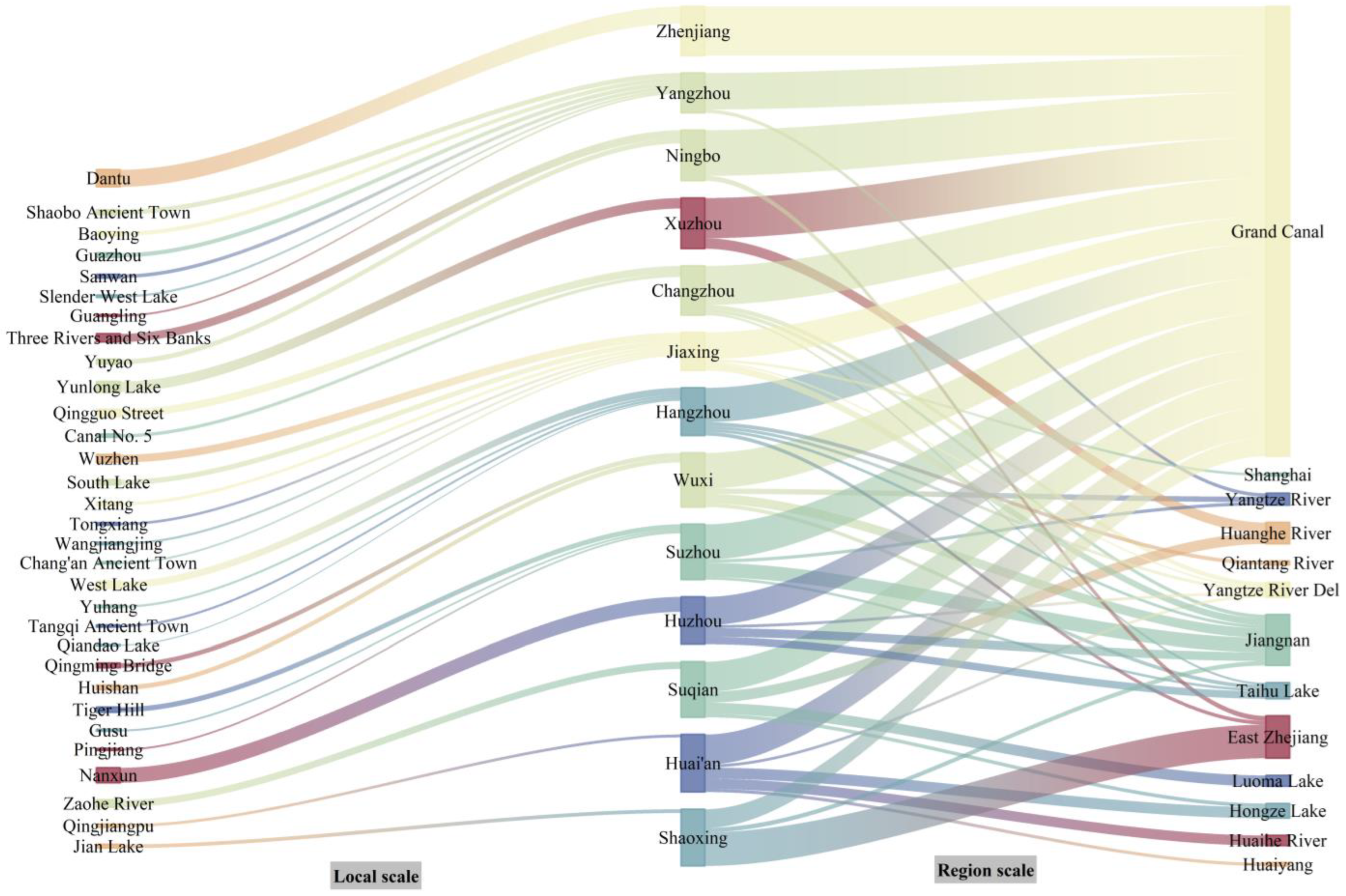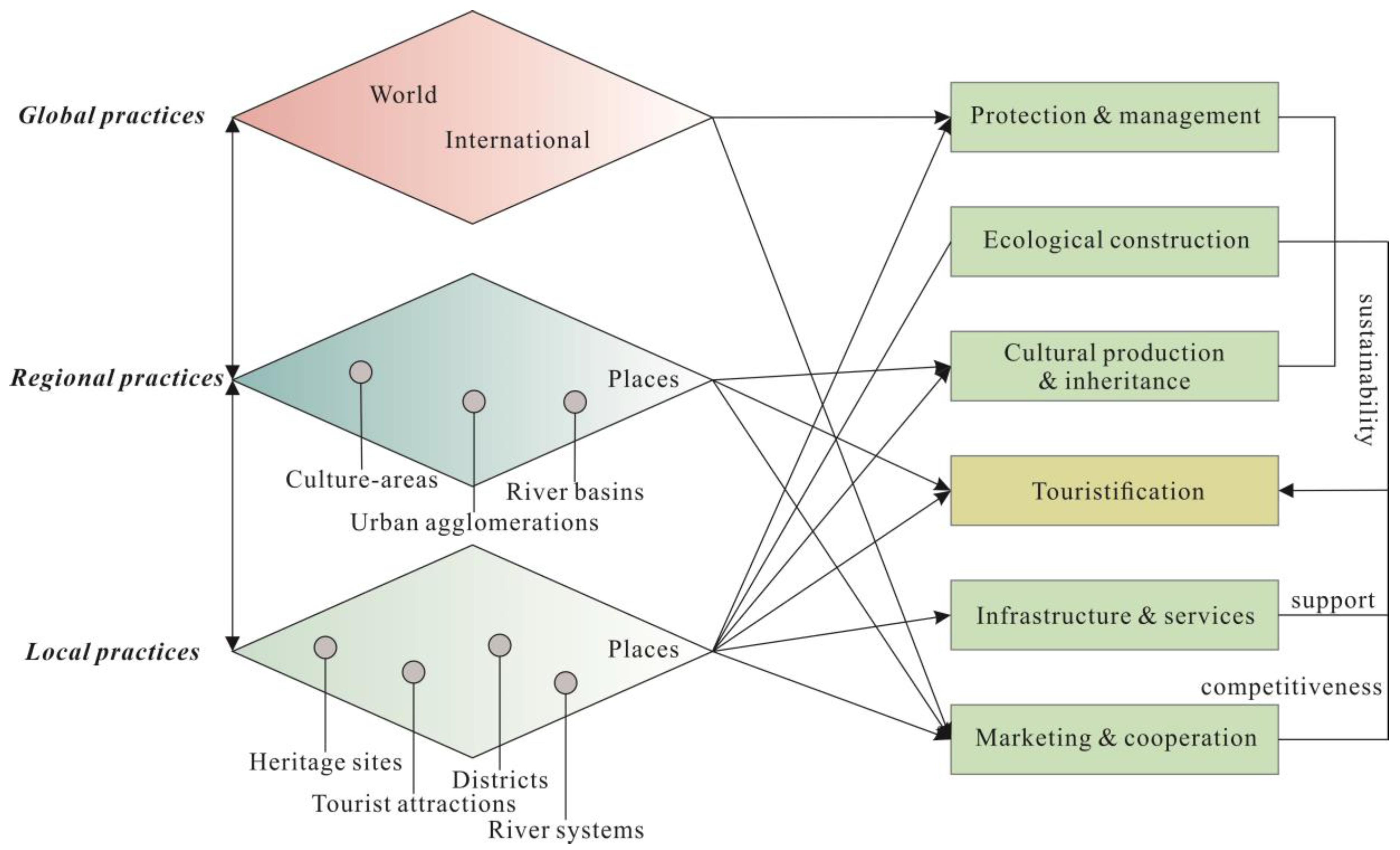The Practice Characteristics of Authorized Heritage Discourse in Tourism: Thematic and Spatial
Abstract
1. Introduction
2. Literature Review
Authorized Heritage Discourse (AHD) and Heritage Tourism
3. Materials and Methods
3.1. Data
3.2. Study Area
3.3. Methods
3.3.1. Dictionary of Stop-Words and Specific Terms
3.3.2. TF-IDF (Term Frequency-Inverse Document Frequency) Algorithm
3.3.3. Latent Dirichlet Allocation (LDA) Topic Modeling
4. Results
4.1. Thematic Characteristics of AHD Practice in Tourism
4.1.1. Protection & Management, Ecological Construction, and Cultural Production & Inheritance
4.1.2. Touristification
4.1.3. Infrastructure and Services
4.1.4. Marketing and Cooperation
4.2. Spatial Characteristics of AHD Practice in Tourism
4.2.1. Global Practices
4.2.2. Regional Practices
4.2.3. Local Practices
4.3. The Relationship between Thematic and Spatial Characteristics of AHD in Tourism
5. Discussion
5.1. Theoretical Contributions
5.2. Practical Implication
5.3. Limitations and Future Research Directions
6. Conclusions
Author Contributions
Funding
Data Availability Statement
Conflicts of Interest
| 1 | We appreciate the valuable suggestion of the review. |
| 2 | Due to space limitations, the specific directory of policy texts is not listed here. If needed, please contact the corresponding author for further details. |
References
- Moore, K.; Buchmann, A.; Månsson, M.; Fisher, D. Authenticity in Tourism Theory and Experience. Practically Indispensable and Theoretically Mischievous? Ann. Tour. Res. 2021, 89, 103208. [Google Scholar] [CrossRef]
- Parga-Dans, E.; González, P.A.; Enríquez, R.O. The Social Value of Heritage: Balancing the Promotion-Preservation Relationship in the Altamira World Heritage Site, Spain. J. Destin. Mark. Manag. 2020, 18, 100499. [Google Scholar] [CrossRef]
- Wang, S.; Lai, I.K.W.; Wong, J.W.C. The Impact of Pluralistic Values on Postmodern Tourists’ Behavioural Intention towards Renovated Heritage Sites. Tour. Manag. Perspect. 2023, 49, 101175. [Google Scholar] [CrossRef]
- Parga Dans, E.; Alonso González, P. Sustainable Tourism and Social Value at World Heritage Sites: Towards a Conservation Plan for Altamira, Spain. Ann. Tour. Res. 2019, 74, 68–80. [Google Scholar] [CrossRef]
- Gravari-Barbas, M. Tourism as a Heritage Producing Machine. Tour. Manag. Perspect. 2018, 25, 173–176. [Google Scholar] [CrossRef]
- Gentry, K.; Smith, L. Critical Heritage Studies and the Legacies of the Late-Twentieth Century Heritage Canon. Int. J. Herit. Stud. 2019, 25, 1148–1168. [Google Scholar] [CrossRef]
- Yagi, T.; Frenzel, F. Tourism and Urban Heritage in Kibera. Ann. Tour. Res. 2022, 92, 103325. [Google Scholar] [CrossRef]
- Harrison, R. Heritage: Critical Approaches; Routledge: London, UK, 2012; ISBN 978-0-203-10885-7. [Google Scholar]
- Emerick, K. Conserving and Managing Ancient Monuments: Heritage, Democracy, and Inclusion; Boydell & Brewer Ltd.: Woodbridge, UK, 2014; ISBN 978-1-84383-909-5. [Google Scholar]
- Waterton, E.; Smith, L.; Campbell, G. The Utility of Discourse Analysis to Heritage Studies: The Burra Charter and Social Inclusion. Int. J. Herit. Stud. 2006, 12, 339–355. [Google Scholar] [CrossRef]
- Winter, T. Clarifying the Critical in Critical Heritage Studies. Int. J. Herit. Stud. 2013, 19, 532–545. [Google Scholar] [CrossRef]
- Smith, L.; Waterton, E. Constrained by Commonsense: The Authorized Heritage Discourse in Contemporary Debates. In The Oxford Handbook of Public Archaeology; Skeates, R., McDavid, C., Carman, J., Eds.; Oxford University Press: Oxford, UK, 2012; ISBN 978-0-19-923782-1. [Google Scholar]
- Hu, X. New Media and Cultural Heritage Politics: The Intertwining of Official Authorised Heritage Discourse, Folk Decentralisation, and Internet Positivity in Chinese Women’s Scripts. Int. J. Herit. Stud. 2023, 29, 547–565. [Google Scholar] [CrossRef]
- Wu, Z.; Hou, S. Heritage and Discourse. In The Palgrave Handbook of Contemporary Heritage Research; Waterton, E., Watson, S., Eds.; Palgrave Macmillan UK: London, UK, 2015; pp. 37–51. ISBN 978-1-349-45123-4. [Google Scholar]
- Waterton, E.; Watson, S. The Ontological Politics of Heritage; or How Research Can Spoil a Good Story. In The Palgrave Handbook of Contemporary Heritage Research; Waterton, E., Watson, S., Eds.; Palgrave Macmillan UK: London, UK, 2015; pp. 21–36. ISBN 978-1-137-29356-5. [Google Scholar]
- Zhang, C.; Yang, J. Construction and Negotiation: Reflections on Relationship between Cultural Heritage and Tourism. Tour. Trib. 2022, 37, 75–84. [Google Scholar] [CrossRef]
- Timothy, D.J. Contemporary Cultural Heritage and Tourism: Development Issues and Emerging Trends. Public Archaeol. 2014, 13, 30–47. [Google Scholar] [CrossRef]
- Timothy, D.J. Making Sense of Heritage Tourism: Research Trends in a Maturing Field of Study. Tour. Manag. Perspect. 2018, 25, 177–180. [Google Scholar] [CrossRef]
- Landorf, C. Managing for Sustainable Tourism: A Review of Six Cultural World Heritage Sites. J. Sustain. Tour. 2009, 17, 53–70. [Google Scholar] [CrossRef]
- Correia, A.; Kozak, M.; Ferradeira, J. From Tourist Motivations to Tourist Satisfaction. Int. J. Cult. Tour. Hosp. Res. 2013, 7, 411–424. [Google Scholar] [CrossRef]
- Wang, Y.; Wang, Y.; Zhang, D.; Zhang, T.; Duan, J.; Wang, K.; Wang, A. A Toponymic Cultural Heritage Protection Evaluation Method Considering Environmental Effects in a Context of Cultural Tourism Integration. Curr. Issues Tour. 2023, 26, 1162–1182. [Google Scholar] [CrossRef]
- Cho, H.D. Relationship between Tourism and Heritage from a Tourist Perspective: Synergy, Complementarity and Antagonism. Curr. Issues Tour. 2022, 25, 1557–1569. [Google Scholar] [CrossRef]
- L’Allégorie Du Patrimoine—Françoise Choay|Cairn.Info. Available online: https://www.cairn.info/l-allegorie-du-patrimoine--9782020300230.htm (accessed on 7 May 2024).
- García-Esparza, J.A. Urban Scene Protection and Unconventional Practices—Contemporary Landscapes in World Heritage Cities of Spain. Land 2022, 11, 324. [Google Scholar] [CrossRef]
- Qiu, Q.; Zuo, Y.; Zhang, M. Intangible Cultural Heritage in Tourism: Research Review and Investigation of Future Agenda. Land 2022, 11, 139. [Google Scholar] [CrossRef]
- Alvarado-Sizzo, I. Spatial Representations, Heritage and Territorial-Synecdoche in Contemporary Tourism. Tour. Geogr. 2023, 25, 467–486. [Google Scholar] [CrossRef]
- Song, H.; Li, G.; Cao, Z. Tourism and Economic Globalization: An Emerging Research Agenda. J. Travel Res. 2018, 57, 999–1011. [Google Scholar] [CrossRef]
- Zhang, S.; Liu, J.; Pei, T.; Chan, C.-S.; Wang, M.; Meng, B. Tourism Value Assessment of Linear Cultural Heritage: The Case of the Beijing–Hangzhou Grand Canal in China. Curr. Issues Tour. 2023, 26, 47–69. [Google Scholar] [CrossRef]
- Wu, M.-Y.; Tong, Y.; Wall, G.; Ying, T. Cultural Production and Transmission in Museums: A Social Practice Perspective. Ann. Tour. Res. 2021, 87, 103130. [Google Scholar] [CrossRef]
- Zhang, S.; Liu, J.; Pei, T.; Chan, C.-S.; Gao, C.; Meng, B. Perception in Cultural Heritage Tourism: An Analysis of Tourists to the Beijing-Hangzhou Grand Canal, China. J. Tour. Cult. Chang. 2023, 21, 569–591. [Google Scholar] [CrossRef]
- Smith, L. Archaeological Theory and the Politics of Cultural Heritage; Routledge: London, UK, 2004; ISBN 978-0-203-30799-1. [Google Scholar]
- Ashton, P. ‘The Birthplace of Australian Multiculturalism?’ Retrospective Commemoration, Participatory Memoralisation and Official Heritage. Int. J. Herit. Stud. 2009, 15, 381–398. [Google Scholar] [CrossRef]
- Ludwig, C. From Bricks and Mortar to Social Heritage: Planning Space for Diversities in the AHD. Int. J. Herit. Stud. 2016, 22, 811–827. [Google Scholar] [CrossRef]
- Xia, C. Fluctuation between AHD and Cultural Intimacy: Heritagisation of a Historic Private House in Qingtian, China. Int. J. Herit. Stud. 2020, 26, 1047–1060. [Google Scholar] [CrossRef]
- Yan, H. World Heritage as Discourse: Knowledge, Discipline and Dissonance in Fujian Tulou Sites. Int. J. Herit. Stud. 2015, 21, 65–80. [Google Scholar] [CrossRef]
- Hingley, R. Ice-Locked Huts, Snow-Buried Cairns, and Sunken Ships: The Prevailing Discourse on Heritage in Antarctica. Int. J. Herit. Stud. 2022, 28, 940–954. [Google Scholar] [CrossRef]
- Linkola, H. Administration, Landscape and Authorized Heritage Discourse—Contextualising the Nationally Valuable Landscape Areas of Finland. Landsc. Res. 2015, 40, 939–954. [Google Scholar] [CrossRef]
- González Martínez, P. Curating the Selective Memory of Gentrification: The Wulixiang Shikumen Museum in Xintiandi, Shanghai. Int. J. Herit. Stud. 2021, 27, 537–553. [Google Scholar] [CrossRef]
- Buzinde, C.N.; Manuel-Navarrete, D. The Social Production of Space in Tourism Enclaves: Mayan Children’s Perceptions of Tourism Boundaries. Ann. Tour. Res. 2013, 43, 482–505. [Google Scholar] [CrossRef]
- Craig Wight, A. Visitor Perceptions of European Holocaust Heritage: A Social Media Analysis. Tour. Manag. 2020, 81, 104142. [Google Scholar] [CrossRef]
- Roppola, T.; Uzzell, D.; Packer, J.; Ballantyne, R. National Identities and War Heritage: Acceptance and Resistance of an Authorised Heritage Discourse among Visitors to the Australian War Memorial. Int. J. Herit. Stud. 2021, 27, 375–390. [Google Scholar] [CrossRef]
- Feng, J.; Dai, L.; Jiang, J.; Wei, R. A Matter of Perspective: A Discursive Analysis of the Perceptions of Three Stakeholders of the Mutianyu Great Wall. IEEE Trans. Prof. Commun. 2018, 61, 22–47. [Google Scholar] [CrossRef]
- Piñeiro-Naval, V.; Serra, P. How Do Destinations Frame Cultural Heritage? Content Analysis of Portugal’s Municipal Websites. Sustainability 2019, 11, 947. [Google Scholar] [CrossRef]
- Smith, K. Using Multidimensional Methods to Understand the Development, Interpretation and Enactment of Quality Assurance Policy within the Educational Development Community. High. Educ. Res. Dev. 2018, 37, 173–187. [Google Scholar] [CrossRef]
- LeGreco, M. Working with Policy: Restructuring Healthy Eating Practices and the Circuit of Policy Communication. J. Appl. Commun. Res. 2012, 40, 44–64. [Google Scholar] [CrossRef]
- Hao, T. Does China’s National Economic and Social Development Plan Have Legal Binding Force? Study Explor. 2007, 99–102. [Google Scholar]
- Zhang, F.; Yang, L.; He, X.; Shi, Y. Recreational Suitability Evaluation for the Heritage Sections along the Grand Canal. Geogr. Sin. 2020, 40, 1114–1123. [Google Scholar] [CrossRef]
- Li, J.; Shan, M.; Qi, J. Coupling Coordination Development of Culture-Ecology-Tourism in Cities along the Grand Canal Cultural Belt. Econ. Geogr. 2022, 42, 201–207. [Google Scholar] [CrossRef]
- Yahav, I.; Shehory, O.; Schwartz, D. Comments Mining With TF-IDF: The Inherent Bias and Its Removal. IEEE Trans. Knowl. Data Eng. 2019, 31, 437–450. [Google Scholar] [CrossRef]
- Li, X.; Law, R.; Xie, G.; Wang, S. Review of Tourism Forecasting Research with Internet Data. Tour. Manag. 2021, 83, 104245. [Google Scholar] [CrossRef]
- Blei, D.M.; Ng, A.Y.; Jordan, M.I. Latent Dirichlet Allocation. J. Mach. Learn. Res. 2003, 3, 993–1022. [Google Scholar]
- Egger, R.; Yu, J. Identifying Hidden Semantic Structures in Instagram Data: A Topic Modelling Comparison. Tour. Rev. 2021, 77, 1234–1246. [Google Scholar] [CrossRef]
- Syed, S.; Spruit, M. Full-Text or Abstract? Examining Topic Coherence Scores Using Latent Dirichlet Allocation. In Proceedings of the 2017 IEEE International Conference on Data Science and Advanced Analytics (DSAA), Tokyo, Japan, 19–21 October 2017; pp. 165–174. [Google Scholar]
- Landorf, C. A Framework for Sustainable Heritage Management: A Study of UK Industrial Heritage Sites. Int. J. Herit. Stud. 2009, 15, 494–510. [Google Scholar] [CrossRef]
- Wang, M.-Y.; Li, Y.-Q.; Ruan, W.-Q.; Zhang, S.-N.; Li, R. Influencing Factors and Formation Process of Cultural Inheritance-Based Innovation at Heritage Tourism Destinations. Tour. Manag. 2024, 100, 104799. [Google Scholar] [CrossRef]
- Guzmán, P.C.; Roders, A.R.P.; Colenbrander, B.J.F. Measuring Links between Cultural Heritage Management and Sustainable Urban Development: An Overview of Global Monitoring Tools. Cities 2017, 60, 192–201. [Google Scholar] [CrossRef]
- Tang, F.; Wang, L.; Guo, Y.; Fu, M.; Huang, N.; Duan, W.; Luo, M.; Zhang, J.; Li, W.; Song, W. Spatio-Temporal Variation and Coupling Coordination Relationship between Urbanisation and Habitat Quality in the Grand Canal, China. Land Use Policy 2022, 117, 106119. [Google Scholar] [CrossRef]
- McKercher, B.; Ho, P.S.Y.; du Cros, H. Relationship between Tourism and Cultural Heritage Management: Evidence from Hong Kong. Tour. Manag. 2005, 26, 539–548. [Google Scholar] [CrossRef]
- Loulanski, T.; Loulanski, V. The Sustainable Integration of Cultural Heritage and Tourism: A Meta-Study. J. Sustain. Tour. 2011, 19, 837–862. [Google Scholar] [CrossRef]
- Zhang, S.-N.; Ruan, W.-Q.; Li, Y.-Q.; Xiao, H. Cultural Distortion Risks at Heritage Sites: Scale Development and Validation. Tour. Manag. 2024, 102, 104860. [Google Scholar] [CrossRef]
- Park, E.; Choi, B.-K.; Lee, T.J. The Role and Dimensions of Authenticity in Heritage Tourism. Tour. Manag. 2019, 74, 99–109. [Google Scholar] [CrossRef]
- De Frantz, M. Tourism Marketing and Urban Politics: Cultural Planning in a European Capital. Tour. Geogr. 2018, 20, 481–503. [Google Scholar] [CrossRef]
- Sequera, J.; Nofre, J. Shaken, Not Stirred: New Debates on Touristification and the Limits of Gentrification. City 2018, 22, 843–855. [Google Scholar] [CrossRef]
- Jansen-Verbeke, M. Tourismification of Historical Cities. Ann. Tour. Res. 1998, 25, 739–742. [Google Scholar] [CrossRef]
- Jraisat, L. Tourism Service Quality and Destination Loyalty-The Mediating Role of Destination Image from International Tourists’ Perspectives. Tour. Rev. 2016, 71, 18–44. [Google Scholar] [CrossRef]
- Bose, S.; Pradhan, S.; Bashir, M.; Roy, S.K. Customer-Based Place Brand Equity and Tourism: A Regional Identity Perspective. J. Travel Res. 2022, 61, 511–527. [Google Scholar] [CrossRef]
- Yin, J.; Qu, X.; Ni, Y. The Marketing of Destination Distinctiveness: The Power of Tourism Short Videos with Enjoyability and Authenticity. Curr. Issues Tour. 2023, 1–13. [Google Scholar] [CrossRef]
- Higgins-Desbiolles, F. Event Tourism and Event Imposition: A Critical Case Study from Kangaroo Island, South Australia. Tour. Manag. 2018, 64, 73–86. [Google Scholar] [CrossRef]
- Can, A.S.; Ekinci, Y.; Pino, G. Joint Brand Advertising for Emerging Heritage Sites. Ann. Tour. Res. 2021, 91, 103294. [Google Scholar] [CrossRef]
- Zhang, M.; Lenzer, J.H., Jr. Mismatched Canal Conservation and the Authorized Heritage Discourse in Urban China: A Case of the Hangzhou Section of the Grand Canal. Int. J. Herit. Stud. 2020, 26, 105–119. [Google Scholar] [CrossRef]
- Wissler, C. The Culture-Area Concept in Social Anthropology. Am. J. Sociol. 1927, 32, 881–891. [Google Scholar] [CrossRef]
- Litvin, S.W.; Mouri, N. A Comparative Study of the Use of “Iconic” versus “Generic” Advertising Images for Destination Marketing. J. Travel Res. 2009, 48, 152–161. [Google Scholar] [CrossRef]
- Chang, T.C.; Milne, S.; Fallon, D.; Pohlmann, C. Urban Heritage Tourism: The Global-Local Nexus. Ann. Tour. Res. 1996, 23, 284–305. [Google Scholar] [CrossRef]




| Number | Topics | Keywords |
|---|---|---|
| 1 | Protection and Management | heritage, protect, work, world, utilize, management, archaeology, monitor, cultural relic, construction, declare, plan, cultural belt, level, material, firing, logo, all-out, river system, environment. |
| 2 | Ecological Construction | construction, ecology, environment, remediation, gallery, project, cultural belt, landscape, engineering, ruins, museum, park, function, National Cultural Park, history, space, comprehensive, style, characteristic, area. |
| 3 | Cultural Production and Inheritance | historical and cultural city, cultural industry, construction, undertaking, cultural belt, tradition, engineering, memory, story, heritage, nation, create, development, masterpiece, quality, utilize, work, celebrity, former residence, strength. |
| 4 | Touristification | tourism, development, cultural tourism, tourist attraction, industry, tourism industry, resort, brand, construction, Grand Canal, holistic tourism, resource, project, cultivate, region, product, experience, acting, nation, integration. |
| 5 | Infrastructure and Services | construction, traffic, base, digital, supply, sightseeing, public service, center, tourism, product, cultural tourism, urban area, consumption, characteristic, village, ecology, project, image, tourist, development. |
| 6 | Marketing and Cooperation | event, marketing, world, international, cultural tourism, tourism, brand, product, cooperation, study, construction, poetry road, resource, theme, exposition, cultural belt, culture and tourism, characteristic, red, famous city. |
| Number | Types (%) | Places |
|---|---|---|
| 1 | Basins (61.54%) | Grand Canal, Yangtze River, Huanghe River, Qiantang River, Taihu Lake, Luoma Lake, Hongze Lake, Huaihe River. |
| 2 | Urban agglomerations (23.08%) | Shanghai, Yangtze River Delta, East Zhejiang. |
| 3 | Culture areas (15.38%) | Jiangnan, Huaiyang. |
| Number | Types (%) | Places |
|---|---|---|
| 1 | Heritage sites (19.35%) | Shaobo Ancient Town, Slender West Lake, Qingming Bridge, Pingjiang, Nanxun, Qingjiangpu. |
| 2 | Tourist attractions (74.19%) | Shaobo Ancient Town, Sanwan, Slender West Lake, Three Rivers and Six Banks, Yunlong Lake, Qingguo Street, Canal No. 5, Wuzhen, South Lake, Xitang, Tongxiang, Wangjiangjing, Chang’an Ancient Town, West Lake, Tangqi Ancient Town, Qiandao Lake, Qingming Bridge, Huishan, Pingjiang, Nanxun, Zaohe River, Qingjiangpu, Jian Lake. |
| 3 | Districts (51.61%) | Dantu, Shaobo Ancient Town, Baoying, Guazhou, Guangling, Yuyao, Wuzhen, Xitang, Tongxiang, Wangjiangjing, Chang’an Ancient Town, Yuhang, Tangqi Ancient Town, Huishan, Tiger Hill, Gusu, Nanxun. |
| 4 | River systems (22.58%) | Slender West Lake, Three Rivers and Six Banks, Yunlong Lake, West Lake, Qiandao Lake, Zaohe River, Jian Lake. |
Disclaimer/Publisher’s Note: The statements, opinions and data contained in all publications are solely those of the individual author(s) and contributor(s) and not of MDPI and/or the editor(s). MDPI and/or the editor(s) disclaim responsibility for any injury to people or property resulting from any ideas, methods, instructions or products referred to in the content. |
© 2024 by the authors. Licensee MDPI, Basel, Switzerland. This article is an open access article distributed under the terms and conditions of the Creative Commons Attribution (CC BY) license (https://creativecommons.org/licenses/by/4.0/).
Share and Cite
Jin, Y.; Hou, B.; Kong, X. The Practice Characteristics of Authorized Heritage Discourse in Tourism: Thematic and Spatial. Land 2024, 13, 816. https://doi.org/10.3390/land13060816
Jin Y, Hou B, Kong X. The Practice Characteristics of Authorized Heritage Discourse in Tourism: Thematic and Spatial. Land. 2024; 13(6):816. https://doi.org/10.3390/land13060816
Chicago/Turabian StyleJin, Yang, Bing Hou, and Xiang Kong. 2024. "The Practice Characteristics of Authorized Heritage Discourse in Tourism: Thematic and Spatial" Land 13, no. 6: 816. https://doi.org/10.3390/land13060816
APA StyleJin, Y., Hou, B., & Kong, X. (2024). The Practice Characteristics of Authorized Heritage Discourse in Tourism: Thematic and Spatial. Land, 13(6), 816. https://doi.org/10.3390/land13060816






